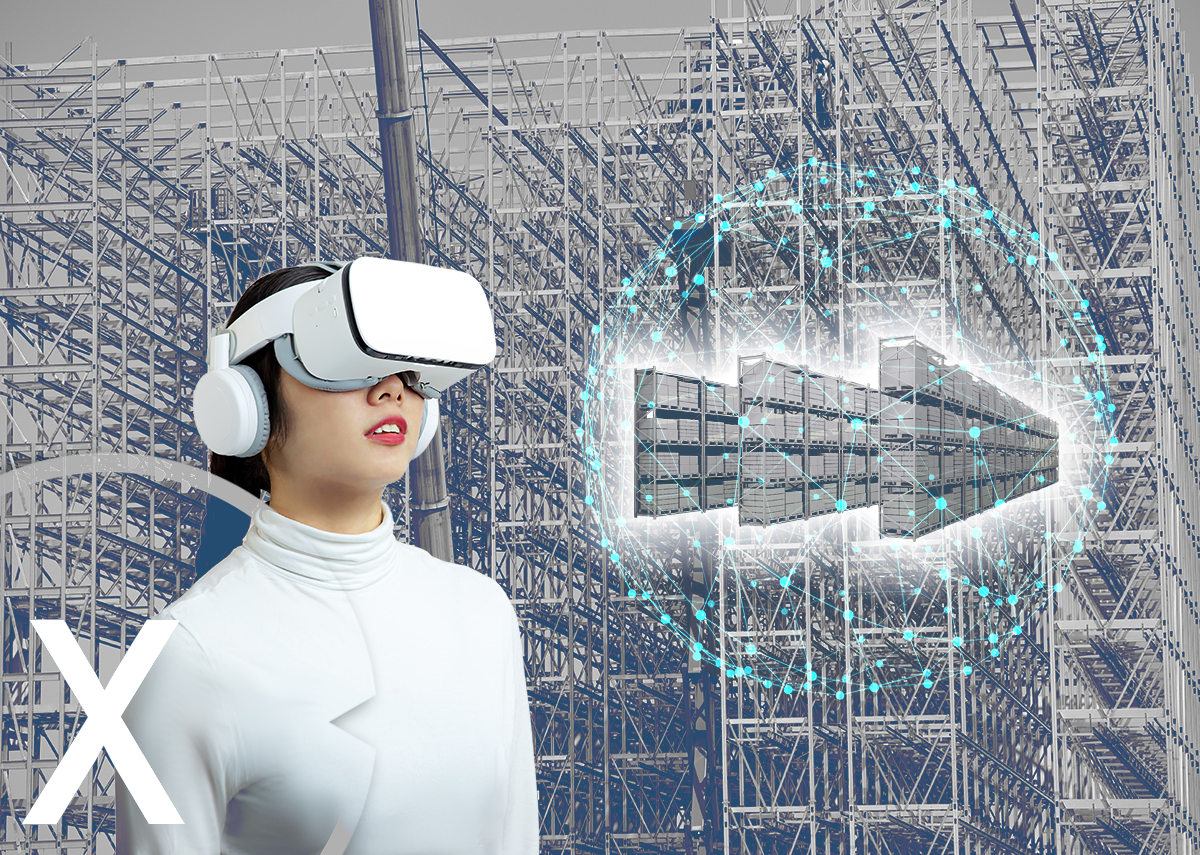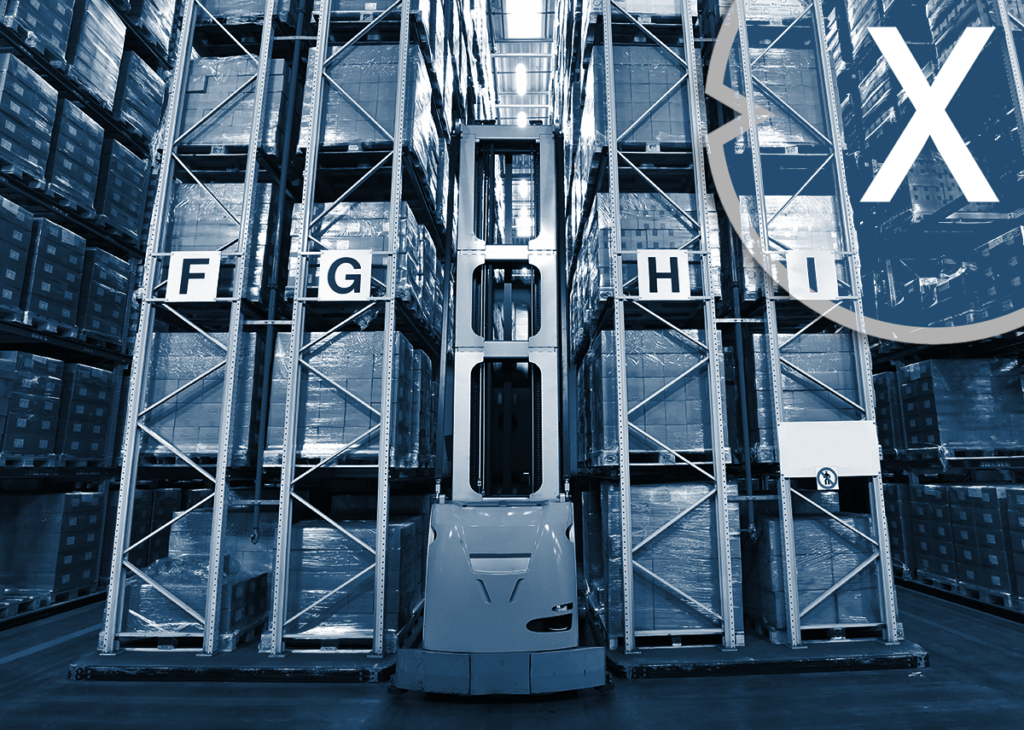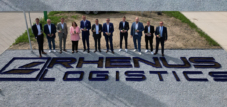High-Bay Warehouse Metaverse and Smart City Logistics 4.0: High-bay warehouse as a driver for efficiency and sustainability
Language selection 📢
Published on: June 27, 2023 / update from: June 27, 2023 - Author: Konrad Wolfenstein
Smart City Logistics 4.0 and the High-Bay Warehouse Metaverse
In the age of digital transformation, virtual worlds and metaverses are playing an increasingly important role. An exciting development is the integration of the High-Bay Warehouse Metaverse into Smart City Logistics 4.0. High-bay warehouses are becoming a central element for increasing efficiency and sustainability in logistics.
The High-Bay Warehouse Metaverse combines virtual reality (VR) with data from real high-bay warehouses. It creates a virtual environment where companies can monitor, analyze and optimize their inventory and logistics processes in real time. The data is extracted from the actual high-bay warehouses using sensors and IoT devices and transferred to the virtual world.
One of the most important applications of the High-Bay Warehouse Metaverse is the simulation and planning of warehouse processes. Companies can play through various scenarios virtually to determine the optimal arrangement of shelves, the best storage strategy and the most efficient routing for the flow of goods. Through these virtual simulations, companies can identify potential bottlenecks and take timely action to ensure smooth logistics.
Another major advantage of the High-Bay Warehouse Metaverse is the ability to remotely monitor and control warehouse processes. Logistics experts can access inventory levels, stacker crane status and other relevant information in real time from any location. This allows them to quickly respond to changes, resolve bottlenecks and increase efficiency without having to be physically there. This saves time and costs for companies and enables effective monitoring of multiple high-bay warehouses at different locations.
A fascinating aspect of the High-Bay Warehouse Metaverse is the integration of artificial intelligence (AI) and machine learning. By analyzing large amounts of data, algorithms can identify patterns and trends to make forecasts about future demand. Based on these insights, companies can optimally manage their inventories to avoid overstocking while ensuring high product availability. This leads to improved resource utilization and reduction in waste.
The combination of high-bay warehouses and the high-bay warehouse metaverse also has a significant impact on sustainability in Smart City Logistics 4.0. By optimizing the flow of goods and accurately managing inventory, companies can reduce inventory while ensuring customer satisfaction. This leads to more efficient use of resources and a reduction in waste. In addition, the integration of renewable energies and energy-efficient technologies in the high-bay warehouses enables more sustainable operation. For example, solar cells on the roofs can generate green energy to meet the warehouse's energy needs.
In addition to increasing efficiency and sustainability, the High-Bay Warehouse Metaverse also offers an immersive experience for logistics professionals and employees. Virtual reality allows you to interactively immerse yourself in the warehouse environment, visualize and better understand the processes. This promotes understanding of the complexity of logistics processes and makes it easier to train new employees.
➡️ The High-Bay Warehouse Metaverse is an innovative and exciting development in Smart City Logistics 4.0. It enables companies to operate high-bay warehouses more efficiently, simulate and optimize warehouse processes virtually, achieve sustainability goals and provide better training for employees. The integration of virtual worlds and real data opens up new opportunities for the logistics industry and will help smart cities become even more efficient, sustainable and technologically advanced in the future.
Our Industrial Metaverse configurator
Just try out our universally applicable (B2B/Business/Industrial) Metaverse configurator for all CAD / 3D demo options:
Xpert (B2B/Business/Industrial) Metaverse configurator for all CAD / 3D data can be used on all devices, one platform!
Suitable for:
High-Bay Warehouse Integration into Smart City Logistics 4.0
The challenges of urban supply in growing cities require innovative solutions to ensure efficiency and sustainability. Smart City Logistics 4.0 relies on the integration of high-bay warehouses as a motor for optimized urban supply. So-called micro-hubs play a crucial role, particularly in the area of last mile logistics.
Last mile logistics, i.e. the final stage of delivering goods from the distribution center to the end consumer, is often associated with inefficient and environmentally harmful processes. This is where micro hubs come into play. These small distribution centers are strategically placed in the city to shorten the last mile of delivery and make delivery more efficient.
The integration of high-bay warehouses into the micro-hubs enables better use of limited urban space. The vertical design of high-bay warehouses allows more goods to be stored in a small area. This reduces the space required by the micro-hubs and creates space for further urban activities and infrastructure projects.
An important advantage of micro-hubs in last mile logistics is the reduction in delivery times. By storing the goods in the high-bay warehouses of the micro hubs, deliveries can be put together quickly and efficiently. This enables faster delivery to end users and significantly shortens delivery times. In addition, the micro hubs can serve as a transshipment point for various types of delivery, such as the use of cargo bikes or electric delivery vehicles.
Another crucial aspect of Smart City Logistics 4.0 is the integration of intelligent technologies and data analysis into the micro-hubs. By using sensors and IoT devices, inventory levels can be monitored and managed in real time. This enables precise inventory planning and avoids overstocks or shortages. In addition, data analyzes enable optimized route planning for delivery based on traffic data, weather conditions and other relevant factors. This leads to more efficient use of resources and a reduction in environmental impact.
The combination of high-bay warehouses and micro hubs in last mile logistics also contributes to sustainability. The physical proximity to end consumers enables shorter delivery routes and reduces the use of vehicles in inner-city areas. This leads to a reduction in traffic congestion, energy consumption and CO2 emissions. In addition, the micro-hubs can be powered by renewable energy to further reduce the ecological footprint.
In addition to increasing efficiency and sustainability, the micro hubs also offer social benefits. Through the decentralized placement of the micro-hubs, jobs can be created in different parts of the city. This can help strengthen the local economy and improve social inclusion. In addition, the micro-hubs could serve as contact points for order pickup, increasing flexibility and convenience for end consumers.
➡️ High-bay warehouses and micro-hubs play a crucial role in overcoming the challenges of urban supply in Smart City Logistics 4.0. They enable efficient storage, optimized last mile logistics and contribute to sustainability. By using intelligent technologies and data analysis, delivery processes can be improved and the impact on the environment can be reduced. The integration of micro-hubs into urban structures creates new opportunities for efficient and sustainable supply of the population.
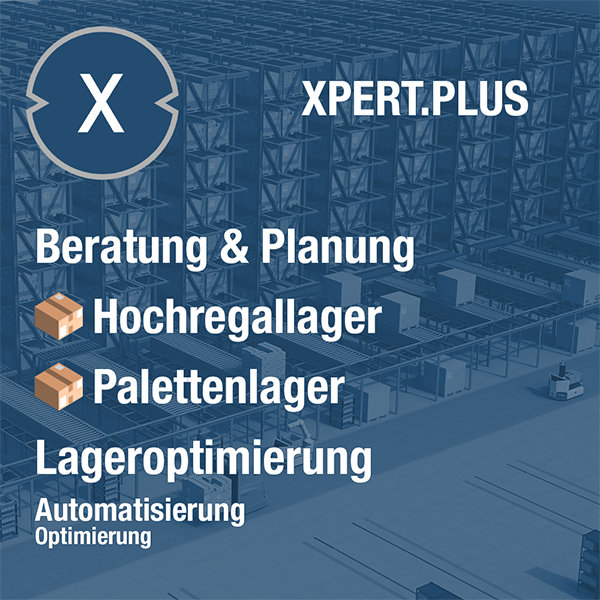
Xpert.Plus warehouse optimization - high-bay warehouses such as pallet warehouses consulting and planning
Is a high-bay warehouse a pallet warehouse?
Yes, a high-bay warehouse can be considered a type of pallet warehouse. A high-bay warehouse is a warehouse where goods are stacked on pallets and stored on high-height shelves. These racks can have multiple levels and are often operated using stacker cranes that move the pallets up and down to the different levels.
Using high bay warehouses allows companies to make the most of available vertical space and maximize storage capacity. By stacking the pallets high, large quantities of goods can be stored in a small area. The high bay warehouse also offers the advantage of efficient use of material handling systems such as forklifts or automated conveyors to move goods in and out of the warehouse.
➡️ A high-bay warehouse is a specific type of pallet warehouse characterized by the use of high-height racks to increase storage capacity.
High-bay warehouse as a driver for efficiency and sustainability
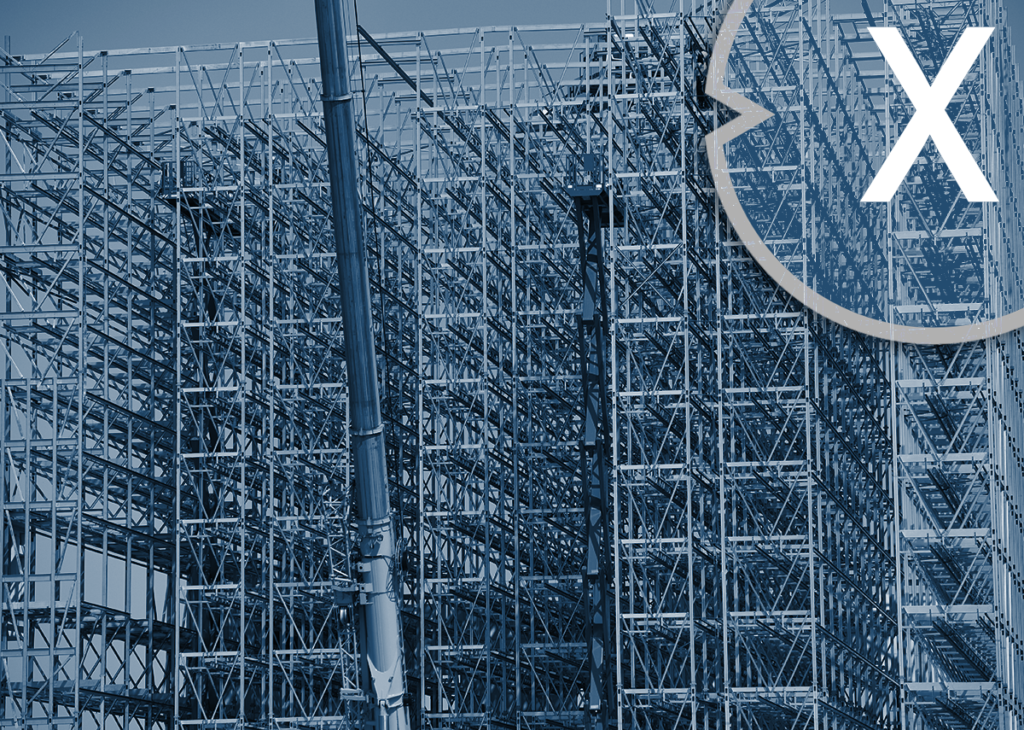
High-bay warehouse as a driver for efficiency and sustainability – Image: Xpert.Digital / Spitzi-Foto|Shutterstock.com
In today's world, when cities around the world are faced with growing populations, increasing traffic volumes and environmental pollution, the development of smart cities is becoming increasingly important. A crucial component for the success of a smart city is efficient and sustainable logistics. The integration of high-bay warehouses plays a central role here.
High-bay warehouses are warehouses that, thanks to their vertical design, enable high storage capacity on a small footprint. They use innovative technologies such as automated storage and retrieval machines, robotic order picking systems and advanced warehouse management systems to make warehouse operations more efficient.
An important aspect of Smart City Logistics 4.0 is the optimization of the flow of goods. High-bay warehouses enable companies to better manage their inventory and optimize the transport of goods. By integrating sensors and data analytics tools, companies can monitor real-time inventory, predict demand, and optimize supply chain planning. This leads to a reduction in inventory, shorter delivery times and more efficient use of resources.
Another important advantage of high-bay warehouses in Smart City Logistics 4.0 is their contribution to sustainability. By using automated systems and intelligent energy efficiency measures, high-bay warehouses can reduce energy consumption and reduce CO2 emissions. For example, the storage and retrieval machines can be equipped with electric drives in order to minimize the use of fossil-fuel-powered vehicles. In addition, solar modules can be installed on the roofs of the high-bay warehouse to generate renewable energy and cover the warehouse's own needs.
The integration of high-bay warehouses into a smart city logistics infrastructure also enables an improved traffic situation in the city. As the storage capacity in high-bay warehouses is increased, more goods can be stored in a smaller space. This reduces the need for large-scale warehouses and frees up space for other urban infrastructure projects. In addition, efficient goods logistics enables the use of environmentally friendly means of transport such as electric vehicles or cargo bikes to minimize the impact of delivery traffic on the environment.
In addition to increasing efficiency and sustainability, high-bay warehouses in Smart City Logistics 4.0 also offer other advantages. Automated warehousing and picking can relieve workers of monotonous and physically demanding tasks. This allows them to concentrate on more demanding and value-adding activities, which leads to increased job satisfaction and productivity.
Overall, high-bay warehouses are an important part of Smart City Logistics 4.0. They improve the efficiency of the flow of goods, contribute to sustainability, relieve the traffic situation and offer numerous advantages for the workforce. By integrating innovative technologies and intelligent systems, high-bay warehouses can serve as a driver for efficiency and sustainability in a smart city. They are a groundbreaking example of the integration of logistics and urban development in the age of digitalization and will help make our cities more livable and sustainable in the future.
Here are the details again on the subject of Smart City Logistics 4.0 and high-bay warehouses:
Increased efficiency through automation
High-bay warehouses use advanced automated systems such as storage and retrieval machines that are able to store and pick goods independently. By automating warehouse processes, companies can significantly increase their efficiency. Errors and bottlenecks that often occur in manual workflows are minimized, resulting in faster completion of logistics processes.
Space saving thanks to vertical design
In densely populated cities, space is often a scarce commodity. High-bay warehouses offer a decisive advantage here as they maximize storage capacity in a small footprint. By using high shelving and automated stacking techniques, companies can fit more goods into a limited space. This enables the efficient use of inner-city areas and creates space for other urban infrastructure projects such as parks or residential areas.
Real-time monitoring and analysis
In a Smart City Logistics 4.0, high-bay warehouses are equipped with sensors that monitor inventory, temperature, humidity and other relevant parameters in real time. This data is continuously analyzed to enable precise inventory management. This allows companies to better forecast demand, avoid bottlenecks and effectively implement just-in-time deliveries. The real-time data also enables a faster reaction to changes in the market and an adjustment of the storage strategy.
Sustainability through energy efficiency
High-bay warehouses can make a significant contribution to sustainability through intelligent energy efficiency measures. For example, storage and retrieval machines can be equipped with regenerative brakes to recover energy when braking. The lighting system can be converted to energy efficient LED technology to reduce power consumption. In addition, automated control and monitoring systems can optimize energy consumption by adapting equipment operating times to actual demand.
Integration of robotics and artificial intelligence
Smart City Logistics 4.0 high-bay warehouses use advanced robotics and artificial intelligence to further optimize warehouse processes. For example, robots can be used in order picking to increase accuracy and speed. By using machine learning and data analysis, algorithms can be continually improved to identify patterns and trends in warehouse data and make more efficient decisions.
Flexibility and scalability
High-bay warehouses offer high flexibility and scalability to meet the changing needs of companies. The shelves can be easily adapted to different sizes and types of goods. In addition, the modular design allows the warehouse to be easily expanded as demand increases. This gives companies the opportunity to flexibly adjust their storage capacity and continuously optimize their logistics processes.
➡️ The integration of high-bay warehouses as a driver for efficiency and sustainability in Smart City Logistics 4.0 offers a variety of advantages for companies, cities and the environment. It enables efficient goods logistics, space savings, real-time monitoring, sustainability and flexibility. These innovative storage solutions help make smart cities more livable, environmentally friendly and sustainable.
Smart City Logistics 4.0
Smart City Logistics 4.0 – current status and further development
Smart City Logistics 4.0 has made great progress in recent years and has developed into a promising solution to the challenges of urban logistics. By integrating cutting-edge technology, data analysis and sustainable concepts, it aims to improve efficiency, sustainability and quality of life in cities. Let's look at the current status of Smart City Logistics 4.0 and take a look at its further development.
At the current stage, many cities around the world are in the process of implementing smart city logistics concepts and implementing practical solutions. Various elements play a role, such as the networking of transport systems, the introduction of electric vehicles, the integration of intelligent traffic control systems and the establishment of micro-hubs for last mile logistics.
A key element in Smart City Logistics 4.0 is connectivity and the exchange of information between the various players in the logistics system. Through the use of sensors, IoT devices and data analysis, logistics processes can be monitored and controlled in real time. This enables precise traffic control, identification of bottlenecks and timely planning of alternative routes. Through the intelligent use of data, traffic flows can be optimized and traffic jams avoided.
Another important aspect is the electrification of the vehicle fleet. Electric vehicles play a central role in Smart City Logistics 4.0 as they can reduce emissions and improve air quality. Cities are increasingly focusing on expanding charging infrastructure and promoting electromobility in order to enable more sustainable logistics. Alternative delivery methods such as cargo bikes and electric vans are also being considered to optimize last-mile delivery.
Micro-hubs are a promising concept that is becoming increasingly important in Smart City Logistics 4.0. These small distribution centers are strategically placed throughout the city and serve as hubs for the final stage of goods delivery. Due to the physical proximity to end consumers, delivery routes can be shortened and more environmentally friendly delivery methods such as pedestrians, bicycles or electric vehicles can be used. The micro-hubs enable more efficient delivery, reduce traffic congestion and improve customer satisfaction.
The further development of Smart City Logistics 4.0 promises even more exciting innovations. With the emergence of new technologies such as autonomous vehicles, drone delivery and robotics, new opportunities are opening up for the logistics industry. Autonomous delivery vehicles could increase delivery efficiency
increase by planning their routes autonomously and precisely. Drones could be used as an alternative delivery method in densely populated areas to speed up last-mile delivery. Robots could support picking and storage in high-bay warehouses and further optimize the processes.
In addition, the integration of artificial intelligence and machine learning will play an increasingly important role. By analyzing large amounts of data, patterns and trends can be identified to forecast demand and optimize resource planning. Intelligent algorithms can analyze traffic patterns and create accurate traffic forecasts to improve delivery times and minimize environmental impact.
➡️ Smart City Logistics 4.0 is in constant development, with the focus on the integration of technology, data and sustainable concepts. Collaboration between cities, companies, research institutions and citizens is crucial to further advance smart city logistics. A holistic and networked approach can increase efficiency, reduce environmental impact and improve the quality of life in cities. The future of Smart City Logistics 4.0 promises smarter, more sustainable and more efficient logistics for urban centers worldwide.
Logistics consultant: Use our Xpert.Plus service for your logistics consulting, warehouse planning or warehouse consulting with automation & component solutions
Xpert.Plus is a project from Xpert.Digital. We have many years of experience in supporting and advising on storage solutions and in logistics optimization, which we bundle in a large network Xpert.Plus
I would be happy to serve as your personal advisor.
You can contact me by filling out the contact form below or simply call me on +49 89 89 674 804 (Munich) .
I'm looking forward to our joint project.
Xpert.Digital – Konrad Wolfenstein
Xpert.Digital is a hub for industry with a focus on digitalization, mechanical engineering, logistics/intralogistics and photovoltaics.
With our 360° business development solution, we support well-known companies from new business to after sales.
Market intelligence, smarketing, marketing automation, content development, PR, mail campaigns, personalized social media and lead nurturing are part of our digital tools.
You can find out more at: www.xpert.digital – www.xpert.solar – www.xpert.plus



